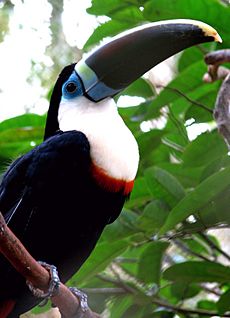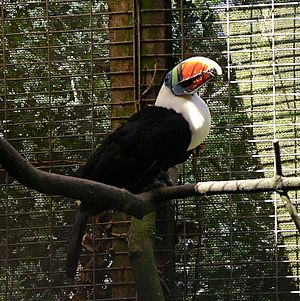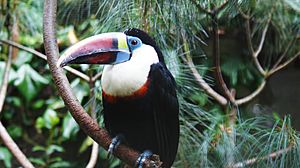White-throated toucan facts for kids
Quick facts for kids White-throated toucan |
|
|---|---|
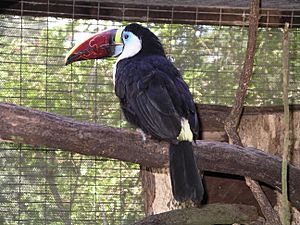 |
|
| Ramphastos t. tucanus | |
| Conservation status | |
| Scientific classification | |
| Genus: |
Ramphastos
|
| Species: |
tucanus
|
| Subspecies | |
|
See text |
|
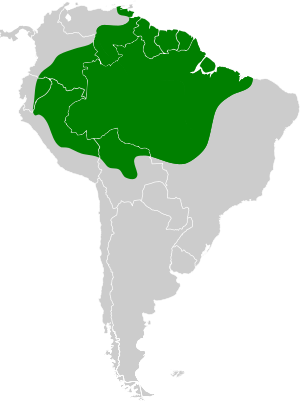 |
|
The white-throated toucan (Ramphastos tucanus) is a colorful bird that lives in the warm, wet forests of South America. You can find it mostly in the Amazon Basin, which is a huge area around the Amazon River. These toucans love tropical forests, but they can also be seen in woodlands and forests near rivers.
Contents
Understanding White-throated Toucan Species
The white-throated toucan was first officially described by a Swedish scientist named Carl Linnaeus in 1758. He put it in the group of birds called Ramphastos, which is the genus for toucans. The name Ramphastos comes from an old Greek word meaning "snouted," referring to their big bills. The word tucanus might come from a local language and mean "bonenose."
Different Types of White-throated Toucans
Scientists recognize three main types, or subspecies, of the white-throated toucan. They are:
- Red-billed toucan (R. t. tucanus): This type is found in places like Venezuela, the Guianas, and northern Brazil.
- Cuvier's toucan (R. t. cuvieri): This type lives in the upper Amazon area, from western Venezuela down to northern Bolivia.
- Inca toucan (R. t. inca): You can find this type in northern and central Bolivia.
The Red-billed toucan and Cuvier's toucan look a bit different, mainly in the color of their bills. But they often breed together where their homes meet. This is why scientists now consider them subspecies, not completely separate species. Some experts even think the Inca toucan might be a natural hybrid (a mix) of the other two types.
What White-throated Toucans Look Like
Like all toucans, the white-throated toucan is very colorful and has a really big bill! These birds are about 50 to 61 centimeters (20 to 24 inches) long. They can weigh from about 425 to 830 grams (0.9 to 1.8 pounds). Male toucans are usually a bit bigger than females.
The largest type, R. t. cuvieri, can be even heavier than the famous toco toucan. Their wings can be 20.4 to 26.5 cm (8 to 10.4 in) long, and their huge bills are 12.2 to 22 cm (4.8 to 8.7 in) long.
These toucans have black feathers on most of their body. Their throat and chest are white, with a thin red line below. Their rump (the area above the tail) is bright yellow, and the feathers under their tail are red. The skin around their eyes is blue.
The bill color changes depending on the subspecies:
- The tip, top edge, and base of the upper bill are yellow.
- The base of the lower bill is blue.
- The rest of the bill is mostly black in R. t. cuvieri and reddish-brown in R. t. tucanus. Toucans that are a mix of these two types will have bills with mixed colors.
Young toucans, called juveniles, have shorter bills and duller, more sooty-black feathers.
How White-throated Toucans Behave
White-throated toucans usually fly in small groups or pairs. They have a heavy, wavy flight and usually don't fly more than 100 meters (330 feet) at a time.
These birds mostly eat fruit that grows on trees. But they also like to snack on insects, lizards, eggs, and even small birds.
White-throated Toucan Reproduction and Life Cycle
Female toucans lay 2 to 4 white eggs in a hollow part of a tree. Sometimes they use an old woodpecker nest in a dead tree.
Both the male and female toucans take turns sitting on the eggs for about 14 to 15 days. When the baby toucans hatch, they are blind and have no feathers. Their bills are short, and they have special pads on their heels to protect them in the nest. Both parents feed the chicks. The young birds leave the nest after about 6 weeks, but their parents continue to feed them for several more weeks.
White-throated Toucans as Pets
Sometimes, people keep white-throated toucans (especially the red-billed type) as pets. However, they can be quite noisy compared to other toucans that people keep, like the keel-billed toucan. It is important to know that it is against the law to take toucans or any other protected wild bird from their natural home.
Protecting White-throated Toucans
The "red-billed" and "Cuvier's" toucans are currently listed as being of "Least Concern" by the IUCN. This means they are not in immediate danger of disappearing. However, the Red-billed toucan was once considered "Vulnerable."
Even though they are "Least Concern," there are still threats. The biggest problem is that their forest homes in the Amazon are being cut down faster and faster. They are also sometimes hunted or captured to be sold as pets.
The white-throated toucan is also listed in CITES Appendix II. This means that trading these birds across countries is controlled to make sure it doesn't harm their wild populations.
See also
 In Spanish: Tucán pechiblanco para niños
In Spanish: Tucán pechiblanco para niños



